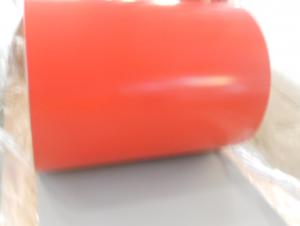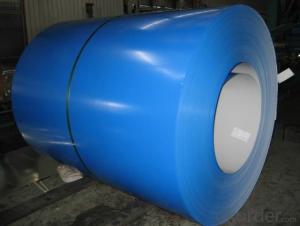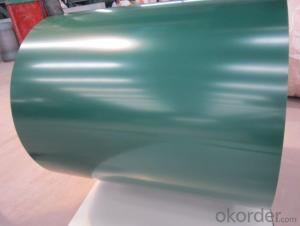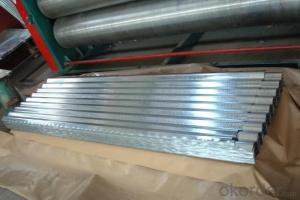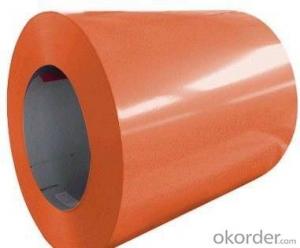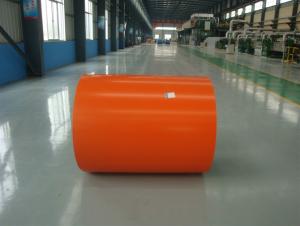PRE-PAINTED ALUZINC STEEL IN COIL
- Loading Port:
- China Main Port
- Payment Terms:
- TT OR LC
- Min Order Qty:
- -
- Supply Capability:
- -
OKorder Service Pledge
OKorder Financial Service
You Might Also Like
Product Description:
Specification
1. Thickness: 0.3-0.8mm
2. Width: 914-1250mm
3. Inner Diameter: 508mm
4. Weight of Steel Coil: 3-15MT
5. Available Dipped Layer: 50-150g/m2
6. Surface Texture: Normal Coated
7. Type of coating structure: 2/1 Coat the top surface of the steel sheet twice, coat the bottom surface once, and bake the sheet twice.
8. Front side paint thickness: 15-25μm (bottome paint + top paint)
9. Back side paint thickness: 5-10μm
Mechanical Properties
1. Mechanical properties of base metals
Grade | Tensile Test | ||
Yield Strength MPa | Tensile Strength MPa | Elongation A80mm % ≥ | |
DC51D+AZ | 280-325 | 320-500 | 22 |
DC52D+AZ | 240-300 | 270-420 | 26 |
DC53D+AZ | 140-260 | 270-380 | 30 |
2. Common performance of front coating
(1). Thickness: ≥20μm
(2). Pencil Hardness: 2H
(3). 60° specular glossiness of coating: >60
(4). 180°bend: ≤3T
(5). Impact: ≥9J
(6). Salt Fog Resistant: ≥500h
(7). Color difference: <3ΔE
- Q: What are the safety precautions when working with steel coils?
- Some safety precautions when working with steel coils include wearing appropriate personal protective equipment (PPE) such as gloves, safety glasses, and steel-toed boots, ensuring proper lifting techniques to prevent musculoskeletal injuries, maintaining a clear and organized work area to avoid tripping hazards, using proper machinery and equipment to handle and transport the coils safely, and following established safety protocols and procedures. It is also important to receive proper training and supervision to handle steel coils effectively and minimize potential risks.
- Q: I should have known, but magnets don't stick to stainless steel, so now I'm at a loss, I can't display my photos on the fridge. any ideas?
- Hi There, I am re-doing my kitchen and since my all stainless steel refrigerator will no longer be used to hold all my memos and pictures, I will hang a magnetic board in one area of my kitchen which will hold all the photos and memos that I had before and it would look very neat this way.. bably much neater than when they were on the fridge. Also, you can get a multiphoto frame for the photos and hang this on the wall. Then, the magnetic board can be just for notes and clips with invitations, etc. Hope this helps.
- Q: How many pounds can steel lift?
- It depends on the type of steel and the geometry of the item.
- Q: Why people prefer prefabricated buildings these days? Recently my friend has told me that he is going to owe a steel house so I was just thinking are these steel structures really durable and cheaper than concrete structures?
- It really depends upon the environment and the construction techniques used. Steel that is painted or coated will without maintenance eventually rust. I would expect this tendency to be exacerbated in a humid or shore environment. Heat may tend to cook a steel house and the structure does not add much thermal mass. Construction techniques tend to be fairly quick a part of the construction is essentially prefabricated. Work done in a factory will almost always be cheaper than work done in the field, all things being equal. Concrete can be fairly hi tech with lots of equipment or as seen in many parts of the world fairly low tech with lots of laborers. It is easy to change the characteristics of concrete depending upon how it is mixed, reinforced, and treated during the curing process. Because it is applied in a relatively fluid state it can flow around obstructions like bedrock and be formed up into interesting shapes. A concrete structure can be cooler as it provides thermal mass, and a heat sink. It's resulting rigidity may make it more subject to earthquakes than steel. We do really need to be smarter in constructing our homes to make them fit the land and not only the general environment but our particular micro environment.
- Q: I know that steel is generally iron with carbon and probably some other things in it, but I'm doing a research paper on architecture in Tokyo, and touching on the Tokyo Tower.The Tokyo work is larger than the Eiffel Tower by 12 meters, but lighter by 3000 tons. The only reason I can find for the difference in weight is that the Tokyo Tower is made of steel and the Eiffel Tower in made of iron, and since the Tokyo Tower is modeled after the Eiffel, there's really not a substantial difference in the amount of metal used....
- For the same volume of part, like a cubic inch, the weight is very close. If you base the comparison on strength, like a bar strong enough to hold XXX pounds, then the forged bar will be lighter, smaller still hold the weight.
- Q: What are the safety standards for steel coil manufacturing?
- To ensure the well-being and protection of workers, as well as the quality and reliability of the products produced, the safety standards for steel coil manufacturing have been designed. These standards encompass various aspects of the manufacturing process and include both general safety guidelines and industry-specific requirements. One of the primary safety standards for steel coil manufacturing involves implementing proper safeguards for machinery and equipment. This entails ensuring that all machinery and equipment used in the manufacturing process are adequately maintained, regularly inspected, and equipped with safety features such as emergency stop buttons and safety guards. Workers must also receive sufficient training on the safe operation of these machines and be aware of potential hazards. Another crucial safety standard is the utilization of personal protective equipment (PPE). Workers engaged in steel coil manufacturing must be provided with appropriate PPE, including safety goggles, gloves, ear protection, and protective clothing, in order to safeguard them against potential hazards such as flying sparks, noise, and chemical exposure. Additionally, safety standards for steel coil manufacturing emphasize the proper handling and storage of materials. This includes guidelines on how to safely lift and transport heavy steel coils, as well as regulations for stacking and storing them to prevent accidents and injuries. Fire safety is also of utmost importance in the safety standards for steel coil manufacturing. Measures should be implemented to prevent and control fires, such as regular inspections of electrical systems, proper storage and handling of flammable materials, and the availability of fire extinguishers and emergency evacuation plans. Furthermore, safety standards necessitate regular safety training and awareness programs for all employees involved in steel coil manufacturing. This ensures that workers are well-informed about potential hazards, safety procedures, and emergency protocols. Regular safety audits and inspections are also conducted to evaluate compliance with these standards and identify areas for improvement. Overall, the safety standards for steel coil manufacturing strive to establish a safe working environment, minimize the risk of accidents and injuries, and ensure the production of high-quality steel coils. Compliance with these standards is crucial for preserving the well-being of workers, protecting the environment, and upholding the reputation of the manufacturing industry.
- Q: How are steel coils used in the manufacturing of springs?
- Steel coils are used in the manufacturing of springs by being compressed or wound into a helical shape, which provides the necessary flexibility and resistance to support various applications.
- Q: What are the safety precautions to be followed while handling steel coils?
- When handling steel coils, there are several safety precautions that should be followed. These include wearing appropriate personal protective equipment, such as gloves and safety glasses, to protect against cuts, abrasions, and eye injuries. It is important to use proper lifting techniques and equipment to prevent strains or back injuries. Steel coils should be securely stacked and stored to prevent them from falling or rolling, and caution should be exercised when moving or transporting them to avoid accidents. Additionally, workers should be trained on the safe handling and storage procedures specific to steel coils to minimize any potential hazards.
- Q: What industries use steel coils?
- Several industries use steel coils, including automotive, construction, energy, manufacturing, and transportation.
- Q: i bought an airsoft gun and it said steel recievers on it im not sure what that is
- It means that the receiver is steel or metal. The receiver is like the bottom and body part of your gun.
Send your message to us
PRE-PAINTED ALUZINC STEEL IN COIL
- Loading Port:
- China Main Port
- Payment Terms:
- TT OR LC
- Min Order Qty:
- -
- Supply Capability:
- -
OKorder Service Pledge
OKorder Financial Service
Similar products
Hot products
Hot Searches
Related keywords


